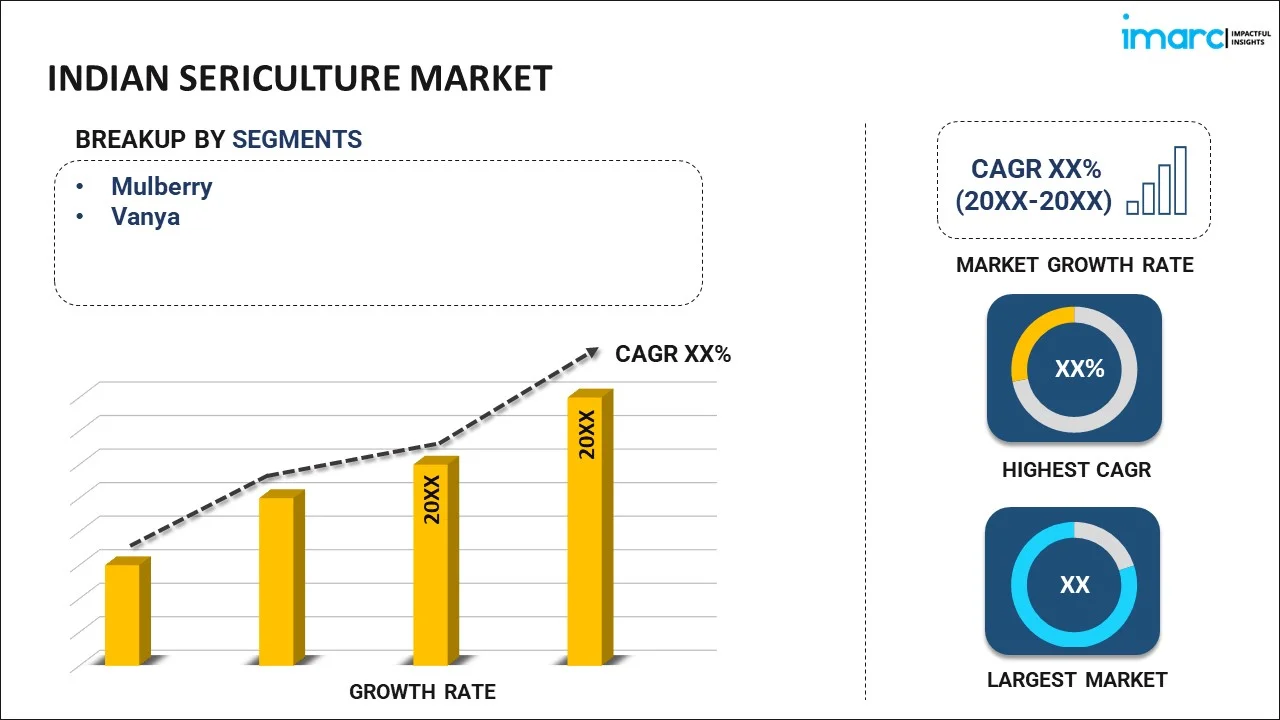
Indian Sericulture Market Report by Segment (Mulberry, Vanya), Domestic Production and Imports (Domestic Production, Imports), Application (Natural Silk Yarns, Fabrics, Made ups, Readymade Garments, Silk Carpets, and Others), and State 2025-2033
Market Overview:
The Indian sericulture market size reached INR 612.7 Billion in 2024. Looking forward, IMARC Group expects the market to reach INR 2,217.5 Billion by 2033, exhibiting a growth rate (CAGR) of 14.6% during 2025-2033.
|
Report Attribute
|
Key Statistics
|
|---|---|
|
Base Year
|
2024
|
|
Forecast Years
|
2025-2033
|
|
Historical Years
|
2019-2024
|
|
Market Size in 2024
|
INR 612.7 Billion |
|
Market Forecast in 2033
|
INR 2,217.5 Billion |
| Market Growth Rate 2025-2033 | 14.6% |
Sericulture refers to the art of rearing silkworms for the production of silk. India is currently the world’s second largest producer of raw silk and the largest consumer of raw silk and silk fabrics.
The market for silk in India is driven by both exports and a very strong domestic demand. Fabrics made up of silk are quite popular in the domestic market during ceremonies, religious rituals, weddings, festivals, etc. Silk is used as a raw material for the manufacturing of both garments such as suites, sarees, etc. as well as in products such as curtains, bed sheets, pillow covers etc. Although silk is currently regarded as a luxury item in India with its price being significantly higher than other fabrics, we expect a continuous increase in disposable incomes to increase the consumption of silk fabrics in the country.
Key Market Segmentation:
IMARC Group provides an analysis of the key trends in each sub-segment of the Indian sericulture market report, along with forecasts at the country and state level from 2025-2033. Our report has categorized the market based on segment, domestic production & imports and application.
Breakup by Segment:

- Mulberry
- Vanya
- Tasar
- Eri
- Muga
Based on the segment, the market has been segregated as Mulberry and Vanya. The Vanya segment has been further segregated as Tasar, Eri and Muga. Mulberry currently represents the biggest segment.
Breakup by Domestic Production and Imports:
- Domestic Production
- Imports
Despite being the world’s second largest producer of silk, the demand of silk outpaces its supply in India. The current gap between production and demand is currently met by domestic production.
Breakup by Application:
- Natural Silk Yarns, Fabrics, Made ups
- Readymade Garments
- Silk Carpets
- Others
On the basis of application, the market has been segmented as natural silk yarns, fabrics and madeups; readymade garments; silk carpets; and others. Natural silk yarns, fabrics and madeups currently represent the largest application area.
Breakup by State:
- Mulberry Silk
- Karnataka
- Andhra Pradesh and Telangana
- West Bengal
- Tamil Nadu
- Others
- Vanya Silk
- Assam
- Jharkhand
- Meghalaya
- Nagaland
- Others
The market has also been segmented on the basis of various states. Karnataka was the leading producer of mulberry silk, whereas Assam is currently the largest producer of Vanya silk.
Competitive Landscape:
The competitive landscape of the market has also been examined in the report.
This report provides a deep insight into the Indian sericulture market covering all its essential aspects. This ranges from macro overview of the market to micro details of the industry performance, recent trends, key market drivers and challenges, SWOT analysis, Porter’s five forces analysis, value chain analysis, etc. This report is a must-read for entrepreneurs, investors, researchers, consultants, business strategists, and all those who have any kind of stake or are planning to foray into the Indian sericulture market in any manner.
Report Coverage:
| Report Features | Details |
|---|---|
| Base Year of the Analysis | 2024 |
| Historical Period | 2019-2024 |
| Forecast Period | 2025-2033 |
| Units | INR Billion, Metric Tons |
| Segment Coverage | Segment, Domestic Production and Imports, Application, State |
| States Covered | Mulberry Silk (Karnataka, Andhra Pradesh and Telangana, West Bengal, Tamil Nadu, Others), Vanya Silk (Assam, Jharkhand, Meghalaya, Nagaland, Others) |
| Customization Scope | 10% Free Customization |
| Post-Sale Analyst Support | 10-12 Weeks |
| Delivery Format | PDF and Excel through Email (We can also provide the editable version of the report in PPT/Word format on special request) |
Key Questions Answered in This Report:
- How has the Indian sericulture market performed so far and how will it perform in the coming years?
- What has been the impact of COVID-19 on the Indian sericulture market?
- What is the breakup of the Indian sericulture market on the basis of various segments?
- What is the breakup of the Indian sericulture market on the basis of domestic production and imports?
- What is the breakup of the Indian sericulture market on the basis of application?
- What is the breakup of the Indian sericulture market on the basis of various states?
- What are the various stages in the value chain of the Indian sericulture market?
- What are the key driving factors and challenges in the Indian sericulture market?
- What is the structure of the Indian sericulture market and who are the key players?
- What is the degree of competition in the Indian sericulture market?
Need more help?
- Speak to our experienced analysts for insights on the current market scenarios.
- Include additional segments and countries to customize the report as per your requirement.
- Gain an unparalleled competitive advantage in your domain by understanding how to utilize the report and positively impacting your operations and revenue.
- For further assistance, please connect with our analysts.
 Inquire Before Buying
Inquire Before Buying
 Speak to an Analyst
Speak to an Analyst
 Request Brochure
Request Brochure
 Request Customization
Request Customization




.webp)




.webp)












